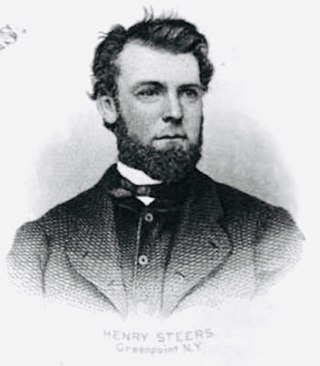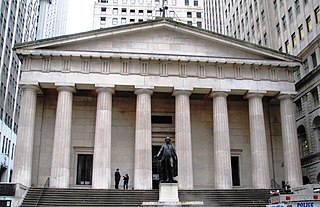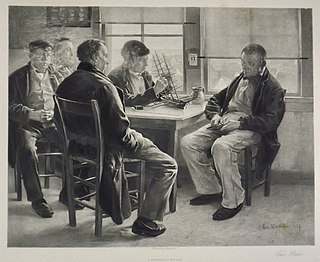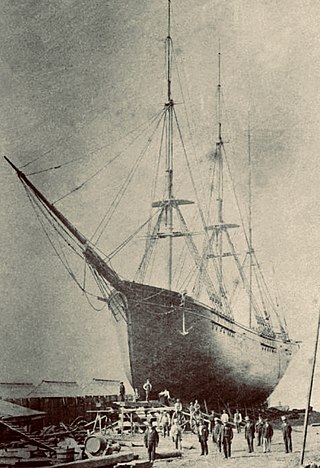
Green-Wood Cemetery is a 478-acre (193 ha) cemetery in the western portion of Brooklyn, New York City. The cemetery is located between South Slope/Greenwood Heights, Park Slope, Windsor Terrace, Borough Park, Kensington, and Sunset Park, and lies several blocks southwest of Prospect Park. Its boundaries include, among other streets, 20th Street to the northeast, Fifth Avenue to the northwest, 36th and 37th Streets to the southwest, Fort Hamilton Parkway to the south, and McDonald Avenue to the east.

James Merritt Ives was an American lithographer, bookkeeper, and businessman. He oversaw the business and financial side of the firm, Currier and Ives, which he co-managed with his business partner, Nathaniel Currier.

Randolph Rogers was an American Neoclassical sculptor. An expatriate who lived most of his life in Italy, his works ranged from popular subjects to major commissions, including the Columbus Doors at the U.S. Capitol and American Civil War monuments.

USS Thomas Freeborn was a steam tug acquired by the Union Navy during the American Civil War. She was used by the Navy as a gunboat to patrol navigable waterways of the Confederacy to prevent the South from trading with other countries.

The Grove Church Cemetery is a nonsectarian cemetery, located on the western slope of the Hudson Palisades, along with several other cemeteries in a string of green open space, in Hudson County, New Jersey, United States. The Grove Church, who owns the cemetery, is one of the oldest religious bodies in the area, and it has had an operating cemetery since 1847. Throughout its history, prominent families have been buried there, as well as American Civil war veterans. There have also been reports of vandalism and misuse of the property since the 19th century, and in 2007 some of the cemetery grounds were occupied by the homeless.

Henry Steers was the son of James Rich Steers, nephew of George Steers, proprietor of Henry Steers' Ship Yard.

Duncan Fraser Curry was an American baseball pioneer and insurance executive.

Tuckahoe marble is a type of marble found in southern New York state and western Connecticut. Part of the Inwood Formation of the Manhattan Prong, it dates from the Late Cambrian to the Early Ordovician ages. It was first quarried on a large scale commercially in the village of Tuckahoe, New York. Deposits are also found in the Inwood area of Manhattan, New York City, in Eastchester, New York, and extending southward to parts of the Bronx, such as Kingsbridge, Mott Haven, Melrose and Tremont and Marble Hill. Other locations in Westchester County include Ossining, Hastings, and Thornwood.

Sandy Hook Pilots are licensed maritime pilots that are members of the Sandy Hook Pilots Association for the Port of New York and New Jersey, the Hudson River, and Long Island Sound. Sandy Hook pilots guide oceangoing vessels, passenger liners, freighters, and tankers in and out of the harbor. The peninsulas of Sandy Hook, and Rockaway in Lower New York Bay define the southern entrance to the port at the Atlantic Ocean.

John Minturn was a three-masted packet ship that was lost on February 14, 1846. The ship left New Orleans headed for New York carrying $80,000 in goods and crew and passengers totaling 51 individuals. Captain Dudley Stark was Master of the ship. Her commander was Dudley Stark, who was a native of Stonington, Connecticut. When the weather got bad, John Minturn took on pilot boat Blossom's Pilot Thomas Freeborn who tried to guide the ship to port.

Richard "Dick" Brown was a 19th-century Sandy Hook pilot. Brown was captain for the 19th-century Sandy Hook pilot boat Mary Taylor. At the time of his death he was the oldest of the Sandy Hook pilots having served for 50 years. He was the captain of the racing yacht America, which won the inaugural America's Cup in 1851.

Edward Francis Williams, was a 19th-century shipbuilder. He apprenticed under his father Jabez Williams. Edward F. Williams built his own shipyard, building clipper ships and eleven Sandy Hook pilot boats, some of the finest boats in the fleet. He was the first president of the Greenpoint Savings Bank. Williams died in New Providence, New Jersey, in 1902.
The Blossom was a 19th-century Sandy Hook pilot boat built for the New York pilots around 1837. She helped transport maritime pilots between inbound or outbound ships coming into the New York Harbor. In 1839, she came across the Slave ship La Amistad. In 1840, there were only eight New York pilot boats, the Blossom being No. 5. Pilot Thomas Freeborn of the Blossom boarded the packet ship John Minturn and tried to guide the ship in bad weather. He was one of thirty-eight passengers that died near the Jersey Shore in 1846.

Josiah Johnson, Jr., was a 19th-century American New York Sandy Hook maritime pilot. He was best known for being in the New York Sandy Hook piloting service for over 47 years. He piloted over 5,000 vessels in and out of the New York Harbor without an accident. Johnson was captain and owner of the pilot boat Edmund Blunt.

The James W. Elwell was a 19th-century two-masted Sandy Hook pilot boat, built in 1867 by John A. Forsyth at Mystic Bridge, New London, Connecticut for New Jersey and Sandy Hook maritime pilots. She raced for a $1,000 prize at the Cape May Regatta in 1873. She went ashore and was shipwrecked on North Beach Haven, New Jersey in 1875.

Theophilus Beebe III was a 19th-century American Sandy Hook Pilot. He was the first pilot to receive his pilot's license under the New Jersey Pilots' Commission in 1837. Beebe served as pilot on the pilot boat Thomas H Smith. He died on January 9, 1867, in Jersey City, New Jersey.
Charles O. Beebe was a 19th-century American Sandy Hook Pilot. He is best known for coming from a multigenerational family of Sandy Hook pilots, the son of James D. M. Beebe and grandson of Theophilus Beebe. Beebe was a World War I veteran. He served on the pilot boat Trenton, No. 4. Beebe lived in Long Branch, New Jersey, his whole life and died on March 5, 1956, at age 84.

Favorite or Favorita, was a 19th-century New York Sandy Hook pilot boat built in the early 1820s. She helped transport New York City maritime pilots between inbound or outbound ships coming into the New York Harbor. Favorite collided with a United States steamer and sank in 1865 near Barnegat Lighthouse.
The Gratitude was a 19th-century Sandy Hook pilot boat built in 1824 by Brown & Bell for New York pilots. She helped transport maritime pilots between inbound or outbound ships coming into the New York Harbor. In 1839, she had a narrow escape from the slave ship La Amistad. In 1839, the Gratitude No. 3, was shipwrecked when a hurricane swept the New York coast. The New Jersey Pilot Boat John McKeon was lost in the same storm.



















